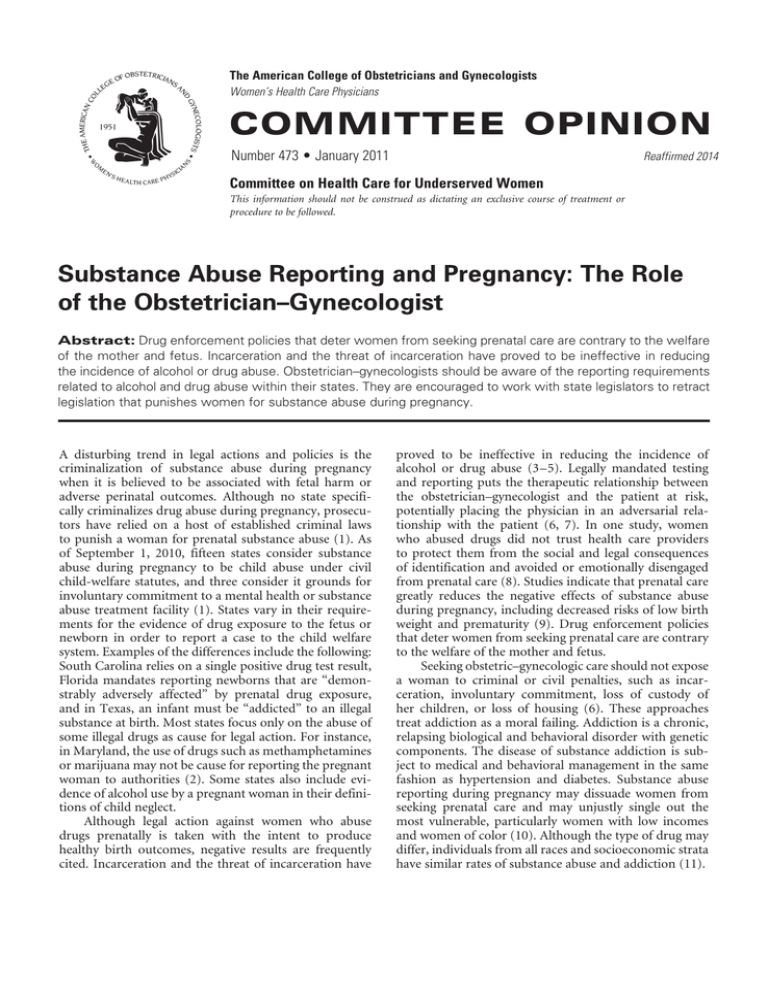
The American College of Obstetricians and Gynecologists
Women’s Health Care Physicians
COMMITTEE OPINION
Number 473 • January 2011
Reaffirmed 2014
Committee on Health Care for Underserved Women
This information should not be construed as dictating an exclusive course of treatment or
procedure to be followed.
Substance Abuse Reporting and Pregnancy: The Role
of the Obstetrician–Gynecologist
Abstract: Drug enforcement policies that deter women from seeking prenatal care are contrary to the welfare
of the mother and fetus. Incarceration and the threat of incarceration have proved to be ineffective in reducing
the incidence of alcohol or drug abuse. Obstetrician–gynecologists should be aware of the reporting requirements
related to alcohol and drug abuse within their states. They are encouraged to work with state legislators to retract
legislation that punishes women for substance abuse during pregnancy.
A disturbing trend in legal actions and policies is the
criminalization of substance abuse during pregnancy
when it is believed to be associated with fetal harm or
adverse perinatal outcomes. Although no state specifically criminalizes drug abuse during pregnancy, prosecutors have relied on a host of established criminal laws
to punish a woman for prenatal substance abuse (1). As
of September 1, 2010, fifteen states consider substance
abuse during pregnancy to be child abuse under civil
child-welfare statutes, and three consider it grounds for
involuntary commitment to a mental health or substance
abuse treatment facility (1). States vary in their requirements for the evidence of drug exposure to the fetus or
newborn in order to report a case to the child welfare
system. Examples of the differences include the following:
South Carolina relies on a single positive drug test result,
Florida mandates reporting newborns that are “demonstrably adversely affected” by prenatal drug exposure,
and in Texas, an infant must be “addicted” to an illegal
substance at birth. Most states focus only on the abuse of
some illegal drugs as cause for legal action. For instance,
in Maryland, the use of drugs such as methamphetamines
or marijuana may not be cause for reporting the pregnant
woman to authorities (2). Some states also include evidence of alcohol use by a pregnant woman in their definitions of child neglect.
Although legal action against women who abuse
drugs prenatally is taken with the intent to produce
healthy birth outcomes, negative results are frequently
cited. Incarceration and the threat of incarceration have
proved to be ineffective in reducing the incidence of
alcohol or drug abuse (3–5). Legally mandated testing
and reporting puts the therapeutic relationship between
the obstetrician–gynecologist and the patient at risk,
potentially placing the physician in an adversarial relationship with the patient (6, 7). In one study, women
who abused drugs did not trust health care providers
to protect them from the social and legal consequences
of identification and avoided or emotionally disengaged
from prenatal care (8). Studies indicate that prenatal care
greatly reduces the negative effects of substance abuse
during pregnancy, including decreased risks of low birth
weight and prematurity (9). Drug enforcement policies
that deter women from seeking prenatal care are contrary
to the welfare of the mother and fetus.
Seeking obstetric–gynecologic care should not expose
a woman to criminal or civil penalties, such as incarceration, involuntary commitment, loss of custody of
her children, or loss of housing (6). These approaches
treat addiction as a moral failing. Addiction is a chronic,
relapsing biological and behavioral disorder with genetic
components. The disease of substance addiction is subject to medical and behavioral management in the same
fashion as hypertension and diabetes. Substance abuse
reporting during pregnancy may dissuade women from
seeking prenatal care and may unjustly single out the
most vulnerable, particularly women with low incomes
and women of color (10). Although the type of drug may
differ, individuals from all races and socioeconomic strata
have similar rates of substance abuse and addiction (11).
Pregnant women who do not receive treatment for
drug dependence cannot be assumed to have rejected
treatment (12). The few drug treatment facilities in the
United States accepting pregnant women often do not
provide child care, account for the woman’s family
responsibilities, or provide treatment that is affordable.
As of 2010, only 19 states have drug treatment programs
for pregnant women, and only nine give priority access to
pregnant women (1).
Obstetrician–gynecologists have important opportunities for substance abuse intervention. Three of the key
areas in which they can have an effect are 1) adhering to
safe prescribing practices, 2) encouraging healthy behaviors by providing appropriate information and education, and 3) identifying and referring patients already
abusing drugs to addiction treatment professionals (13).
Substance abuse treatment programs integrated with prenatal care have proved to be effective in reducing maternal and fetal pregnancy complications and costs (14).
The use of the legal system to address perinatal alcohol
and substance abuse is inappropriate. Obstetrician–gynecologists should be aware of the reporting requirements
related to alcohol and drug abuse within their states. In
states that mandate reporting, policy makers, legislators,
and physicians should work together to retract punitive
legislation and identify and implement evidence-based
strategies outside the legal system to address the needs
of women with addictions. These approaches should
include the development of safe, affordable, available,
efficacious, and comprehensive alcohol and drug treatment services for all women, especially pregnant women,
and their families.
Resource
Guttmacher Institute. Substance abuse during pregnancy.
State Policies in Brief. New York (NY): GI; 2010. Available at: http://www.guttmacher.org/statecenter/spibs/
spib_SADP.pdf. Retrieved September 10, 2010.
This report lists policies regarding prosecution for substance abuse during pregnancy and drug abuse treatment
options for pregnant women for each state. It is updated
monthly.
References
1.Guttmacher Institute. Substance abuse during pregnancy.
State Policies in Brief. New York (NY): GI; 2010. Available at:
http://www.guttmacher.org/statecenter/spibs/spib_SADP.pdf.
Retrieved September 10, 2010.
2. Paltrow LM, Cohen DS, Carey CA. Governmental responses
to pregnant women who use alcohol or other drugs: year
2000 overview. New York (NY): National Advocates for
Pregnant Women; Philadelphia (PA): Women’s Law
Project; 2000.
2
3. Poland ML, Dombrowski MP, Ager JW, Sokol RJ. Punishing
pregnant drug users: enhancing the flight from care. Drug
Alcohol Depend 1993;31:199–203.
4.Chavkin W. Drug addiction and pregnancy: policy crossroads. Am J Public Health 1990;80:483–7.
5. Schempf AH, Strobino DM. Drug use and limited prenatal
care: an examination of responsible barriers. Am J Obstet
Gynecol 2009;200:412.e1–412.e10.
6.At-risk drinking and illicit drug use: ethical issues in
obstetric and gynecologic practice. ACOG Committee
Opinion No. 422. American College of Obstetricians and
Gynecologists. Obstet Gynecol 2008;112:1449–60.
7. Legal interventions during pregnancy. Court-ordered medical treatments and legal penalties for potentially harmful
behavior by pregnant women. JAMA 1990;264:2663–70.
8. Roberts SC, Nuru-Jeter A. Women’s perspectives on screening for alcohol and drug use in prenatal care. Womens
Health Issues 2010;20:193–200.
9.El-Mohandes A, Herman AA, Nabil El-Khorazaty M,
Katta PS, White D, Grylack L. Prenatal care reduces the
impact of illicit drug use on perinatal outcomes. J Perinatol
2003;23:354–60.
10.Maternal decision making, ethics, and the law. ACOG
Committee Opinion No. 321. American College of
Obstetricians and Gynecologists. Obstet Gynecol 2005;106:
1127–37.
11.Chasnoff IJ, Landress HJ, Barrett ME. The prevalence of
illicit drug or alcohol use during pregnancy and discrepancies in mandatory reporting in Pinellas County, Florida.
N Engl J Med 1990;322:1202–6.
12.Flavin J, Paltrow LM. Punishing pregnant drug-using
women: defying law, medicine, and common sense. J Addict
Dis 2010;29:231–44.
13. Safe use of medication. ACOG Committee Opinion No. 331.
American College of Obstetricians and Gynecologists.
Obstet Gynecol 2006;107:969–72.
14. Armstrong MA, Gonzales Osejo V, Lieberman L, Carpenter
DM, Pantoja PM, Escobar GJ. Perinatal substance abuse
intervention in obstetric clinics decreases adverse neonatal
outcomes. J Perinatol 2003;23:3–9.
Copyright January 2011 by the American College of Obstetricians and
Gynecologists, 409 12th Street, SW, PO Box 96920, Washington,
DC 20090-6920. All rights reserved. No part of this publication may
be reproduced, stored in a retrieval system, posted on the Internet,
or transmitted, in any form or by any means, electronic, mechanical, photocopying, recording, or otherwise, without prior written
permission from the publisher. Requests for authorization to make
photocopies should be directed to: Copyright Clearance Center, 222
Rosewood Drive, Danvers, MA 01923, (978) 750-8400.
ISSN 1074-861X
Substance abuse reporting and pregnancy: the role of the obstetrician–gynecologist. Committee Opinion No. 473. American College of
Obstetricians and Gynecologists. Obstet Gynecol 2011;117:200–1.
Committee Opinion No. 473





